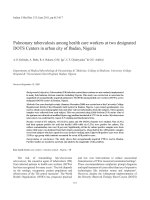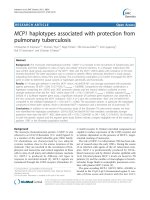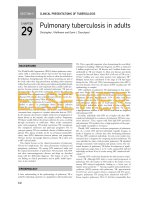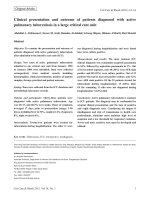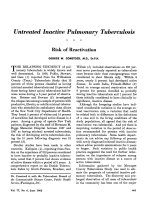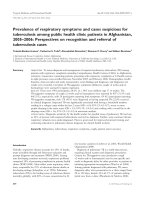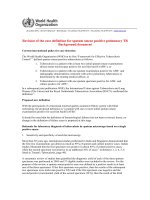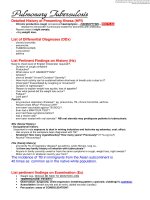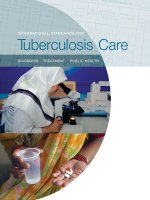Multi-level Image Enhancement for Pulmonary Tuberculosis Analysis doc
Bạn đang xem bản rút gọn của tài liệu. Xem và tải ngay bản đầy đủ của tài liệu tại đây (332.44 KB, 5 trang )
Chandrika V et al., International Journal of Science and Advanced Information Technology, 1 (4), September – October 2012, 102-106
102
@ 2012, IJSAIT All Rights Reserved
Multi-level Image Enhancement for Pulmonary Tuberculosis Analysis
Chandrika V.
1
, Parvathi C.S
2
., and P. Bhaskar
3
Department of Instrumentation Technology,
Gulbarga University P G. Centre, Yeragera – 584 133.
Raichur, Karnataka,India
ABSTRACT
The paper presents the task of auto-detecting the tiny
nodules, which will help to get more information of
pulmonary tuberculosis (TB). We apply two image
processing technique into lung tissue information
recognition. (1) A repetitive smoothing-sharpening
technique is proposed and its impact is assessed to
beneficially enhance X-ray lung images. (2) The
ridge detection algorithm is going to diagnose
indeterminate nodules correctly, allowing curative
resection of early-stage malignant nodules and
avoiding the morbidity and mortality of surgery for
benign nodules. The proposed technique is tested on
lung X-ray images. Results show that the proposed
methodology has high potential to advantageously
enhance the image contrast hence giving extra aid to
radiologists to detect and classify TB.
Keywords: X-ray Lung Image Enhancement, Hybrid
Image Enhancement, Repetitive Image Enhancement,
Canny Edge Detection, Laplacien Filtering, Wavelet
Transformation, Tuberculosis Cavities
1. INTRODUCTION
The aim of image processing and image segmentation
in this paper is to auto-detecting tuberculosis cavities
from the lung X-ray image [1-2]. Therefore, earlier
and more certain detection with more effective
screening methods can be expected to improve cure
rates. The paper presents that to detect tiny
tuberculosis cavities from X-ray image, which may
present the characteristic of pulmonary tuberculosis
and proposes an algorithm that incorporates newer
imaging and diagnostic methods to facilitate the
evaluation and management of removing the
pulmonary tuberculosis cavities.
In the earlier technique of detecting TB, the method
was involved with only segmentation using which the
feature extraction was done [10]. The neural network
was designed with (100-50-10-2) back progression.
This system provided the result as accuracy,
sensitivity and specificity at 74.45%, 83.33%, and
66.7% respectively. To increase the result in tems of
detecting the TB we adopted another technique along
with the existing one. That is we have included
enhancement before feature extraction to identify the
smallest information available in the lung region to
detect TB.
The developed technique involves contrast
enhancement using sequentially iterative smoothing
filters, histogram equalization, and simultaneous
application of two types of edge detection processes
namely, maximum-difference edge detection [3] and
Canny’s edge detection [4]. The post processed
image is combined with the original image to
accentuate the edges while eliminating noise.
Smoothing is implemented because of its effect to
reduce specific types of noise signals in the digitized
image. However, singular application of smoothing
filter does not always provide beneficial results,
especially if it is applied to noisy images that are
characterized by considerably low signal-to noise
ratio. Hence, we proposed an iterative smoothing
filter that apply the filter repetitively and obtain
series of results for assessment. On the other hand,
edge detection aims at increasing the contrast and
accentuating the intensity difference. Hybridizing the
edge detection with the smoothing filter will increase
the contrast, thus help to improve the diagnostic
power of the x-ray lung, however different edge
detection techniques have varying impact on the
resulting images. In this work we have combined two
types of image sharpening and edge detection
techniques. Figures 1(a) & 1(b) show the block
diagrams of the proposed Tuberculosis auto detecting
system.
I
SSN No. 2278
-
3083
Volume 1, No.4, September – October 2012
International Journal of Science and Applied Information Technology
Available Online at
Chandrika V et al., International Journal of Science and Advanced Information Technology, 1 (4), September – October 2012, 102-106
103
@ 2012, IJSAIT All Rights Reserved
Figure 1
Figure 2
Figure 1 & 2: Block diagrams of the overall
proposed system
2. METHODOLOGY
Detecting the tuberculosis cavities from the X-ray
image, and that is the target for research. The aim of
image processing and image segmentation is to auto-
detect tuberculosis cavities, which is one of the most
difficult tasks in image processing. Segmentation
algorithms for X-ray images generally are based on
one of two basic properties of gray-level values:
discontinuity and similarity will accord with the
requirement [5].
Algorithm I
The proposed repetitive smoothing-sharpening
technique employs a number of sequential and also
parallel steps. In the first processing step a discrete
Laplace high pass operator filter is applied to reduce
the noise and enhance the image contrast by
eliminating as much noise as possible.
Figure 3: comparison of segmented & filtered X-ray
image
Figure 3 shows an example of this step result as
applied to x-ray lung samples. The output image from
this step is used as input to two individual parallel
modules namely Module G and Module B, after
performing color separation as shown in Figure 5,
where it will undergo further and different processing
within these modules and later the outputs are
combined with another copy of the image as gained
from the first step of the developed technique to
produce the enhanced output image. Prior to start
modules G and B process, calculation of the standard
deviation of the intensities is carried out which is
measured as a reflection of contrast R (RMS
contrast):
(1)
Where
, M and N are the image number of rows and columns
respectively and I is the intensities average value. In
module B iterative smoothing is applied to the input
image data. The number of repetitions is determined
by implementing a preset threshold level of iteration
decision factor H. The image is smoothed by taking
the average of the nine pixel blocks; eight
neighboring pixels in addition to the pixel under
investigation, Figure 4.
Figure 4: Pixel Neighborhood Representation
The output is then stored into an output array S,
hence S is calculated as follow:
(2)
The S output data array is then used to compute a
new σ value by application of Equation 1. A
comparison is made between the (H*σ) and the new
resulting σ value. Additional smoothing step is then
repeated if the newly computed σ is ≥ (H*σ). The
same process is repeated till the newly computed
value of σ becomes less than the value of (H*σ).The
main purpose of iterative smoothing is to eliminate as
Chandrika V et al., International Journal of Science and Advanced Information Technology, 1 (4), September – October 2012, 102-106
104
@ 2012, IJSAIT All Rights Reserved
much as possible of noise from the signal. Although
it might seem contra intuitive to smooth an image for
contrast increasing, but the proposed and developed
technique employ the technique as it balances out the
draw back in its next steps resulting in enhanced
contrast. The edge array histogram is then equalized
using the following equation:
where Mean(S) and σ(S) are the mean value and the
standard deviation of the resulting intensities in the S
array. Canny’s edge detection filter [8] is then
applied to the filtered image to accentuate contours of
the possible Regions of Interests (ROIs) that could
have been missed by the edge detection in the
pathway (i.e. Module G).Whereas Module G applies
mean blurring filter to eliminate noise while
preserving most of the details. Next the edge
attributes in the image data is determined by
application of maximum difference of pixel intensity
as follow [4].
For each pixel, the difference in intensities between
the center point and the 8 neighbors, Figure 4, is
determined and the max of those is assigned as the
new intensity of the center point in array E:
The average value of the resulting pixels’ intensities
is determined using the values from the final output
of the E array. This computed average is then
subtracted from all pixels’ intensities (i.e. histogram
left-shift). The purpose of this step is to eliminate the
background low intensity pixels. The process is
calculated as follow:
Where is the output image data array generated from
the intensity subtracting process. Further filtering is
applied to isolate resulting edge point that do not
have counterpart in the original image.
The three outputs as outlined by Figure 2 flow chart
are then superimposed as three bands of RGB domain
by assigning the Red-band to the post-Laplacian
image, the Green-band to the filtered and normalized
edge detection, and the Blue-band to the Canny’s
edge Detection contours from sequentially blurred
and normalized image. The 24-bit image is then
converted into 8-bit grey-scale array as shown in
Figure 6, using Pal model to readily enable
comparison with the original gray-scale image.
Figure 5 Color Separation of color image
Figure 6. 24-bit color and 8-bit gray color
enhancement of proposed algorithm
Algorithm II
The algorithm is expressed as follows:
(A) Given an initial threshold T (between 64 and
128);
(B) Using global or local (i.e., adaptive) threshold
operator on a gradient magnitude image and getting
the high frequency component h (x, y) from the
highpass filter;
(C) Doing edge detection and gaining the
observability Image j (x,y);
(D) Citing the subtraction algorithm to deal with the
signals between j (x,y) and h(x,y), and gaining the
details of different orientations of image g (x, y) from
the wavelets filter.
In the follow section, each step is explained with
resultant image. Considering the algorithm (A) and
(B), the histogram of typical chest X-ray image is
produced. The histogram shows two almost distinct
clusters of X-ray numbers. To recover the edges, the
Chandrika V et al., International Journal of Science and Advanced Information Technology, 1 (4), September – October 2012, 102-106
105
@ 2012, IJSAIT All Rights Reserved
gradient image must be segmented using a global or
local (i.e. adaptive) threshold operator. Detecting the
tuberculosis cavities from the X-ray image, and that
is the target for research. In spite of the characteristic
noise, the lowpass filter and high-pass filter could not
directly reveal tuberculosis cavities from the image
(see Figure 7 (a) (b) (c)). Indeed, the directness of
using the filters could not account for this target.
However, Laplacian is a derivative operation, which
use highlights gray leave discontinuities in an image
with slowly varying gray leave [6]. This will meet
our needs whereas, the Canny edge detector [5] is the
most rigorously expatiate upon operator, the result is
not observability as before (see Figure. 6(d)).
Figure 7. TB cavities detection (a) Image from
Algorithm I (b) Low-pass filter detection, (c) The
high-pass filter result, (d) Canny edge detection.
The key usefulness of Image subtraction is
enhancement of difference. It is available to use
subtraction algorithm to realize the distributing of the
pathological tissue. In this section,
When g(x,y) = f (x,y)-h(x,y) < 0 (7)
The value of g (x, y) will be changed as fellow:
g(x,y) = 0 and when, (8)
(x,y) = f (x,y)-h(x,y) >0 (9)
The value of g(x, y) will not be changed. Therefore,
all cases of known or suspected lung cancer or
pulmonary tuberculosis should be initially
approached with curative intent (see Fig.7 (d)).
Figure 8. (a) The low-frequency component of
Figure 7(d), (b) The horizontal details (a), (c) The
diagonal details of (a), and (d) vertical details of (a).
The solitary pulmonary tuberculosis cavities are
usually an unexpected finding on a chest film [8].
The wavelets algorithm is aim to detecting the details
of different orientations of object [9]. Based on the
features (D) and (E), the octave-band decomposition
is used to decompose the low frequency field into
more narrow frequency field e (see Figure. 8(a-d)).
Simultaneously, the part of high frequency
component is not to keep up decompose. After
detection of the early lung cancer X-ray image, most
significant information exists in the image.
3. RESULTS
For testing, we used a four-layered BP network (100-
50-10-2), including an input layer, an output layer,
and a hidden layers, in accordance with TB features.
The network was trained by ‘traingdm’ with ‘tansig’
activation function for the hidden layer, and ‘purelin’
linearity function for output. In this process, the
target error was 0.003 and the biggest training time
was 2000 epochs. Accurate rate, sensitivity, and
specificity of our diagnosis were 91.25% (73/80),
90.48% (38/42), and 92.11% (35/38), respectively.
Chandrika V et al., International Journal of Science and Advanced Information Technology, 1 (4), September – October 2012, 102-106
106
@ 2012, IJSAIT All Rights Reserved
Diagnostic
result
Status of disease
Total
TB Non-TB
TB 38 03 41
Non-TB 04 35 39
Total 42 38 80
Table 1: Diagnostic Result of Testing Samples
Comparatively by adding this enhancement method,
we have achieved 16.18% of improvement in its
accuracy of classification TB.
4. CONCLUSION
The paper presents a novel, wavelet transform based
and subtraction algorithm that incorporates newer
imaging and diagnostic methods to facilitate the
evaluation and management of solitary pulmonary
tuberculosis cavities. Management of tuberculosis
cavities that are clearly benign or malignant is
straightforward. The difficulty is in the evaluation
and management of the indeterminate nodule and the
goal is to correctly diagnose indeterminate
tuberculosis cavities, allowing curative resection of
early-stage malignant tuberculosis cavities and
avoiding the morbidity and mortality of surgery for
benign tuberculosis cavities. From the test results, the
proposed technique was successful in detecting tiny
cavities on lung X-ray image. This is found to have
many advantages over the exiting methods.
Acknowledgement
The authors are very grateful to Mrutyunjaya S.
Hiremath, CTO, eMath Technology, India for
interesting discussions regarding this work.
REFERENCES
1. A. Jemal, R. Siegel, E. Ward, Y. Hao, J. Xu, and
MJ. Thun. Cancer statistics,CA Cancer J Clin.,
Vol.59, pp. 225-249, 2009
.
2. World Health Organization WHO “Cancer”
Fact sheet No.297, February 2009,
who.int/mediacentre/ factsheets/fs297/en/index.html.
3. H. Madjar. Role of Breast Ultrasound for the
Detection and Differentiation of Breast Lesions.
Breast Care 2010;5:109-114 (DOI:
10.1159/000297775)
4. R. F. Chang, C. J. Chen, M. F. Ho, D. R. Chen and
WK Moon. Breast ultrasound image classification
using fractal analysis. Proceedings of the Fourth
IEEE Symposium on Bioinformatics and
Bioengineering, 2004. BIBE 2004.
5. Y. Guo, H. Cheng, J. Huang, J. Tian, W. Zhao, L.
Sun and Y. Su. Breast ultrasound image
enhancement using fuzzy logic, Ultrasound in
Medicine & Biology, Vol.32, Issue. 2, pp. 237-247,
Feb 2006.
6. L.E Romans. Introduction to Computed
Tomography, Springer (1995)
7. R. G. Gonzale and R.E. Woods. Digital Image
Processing, Addison Wesley, New York (1993).
8. Marr D. and E. Hildreth. Theory of Edge
detection, Proc. Royal Society of London, vol. B-
207, 1980, pp. 187-217.
9. Canny J. A computational Approach to Edge
Detection, IEEE Trans. Pattern Analysis and
Machine Intelligence, Vol. 8, No. 6, 1986, pp. 679-
698.
10. Chandrika V, Parvathi C.S and Bhaskar P.
Multifeatured Automatic Tuberculosis Detection
System, Vol 3, No.3 June 2012 Science Publisher U
K pp 1601-1605.
